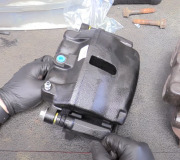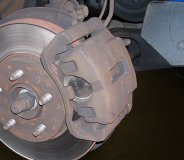The next time this happens, stop on a slight incline, shift to neutral, and place a block about a foot downhill from one tire so you don't look silly running after the car when the brake releases. The secret now is to open the hydraulic system at various places to see where the brake fluid is being trapped.
If you open the bleeder screw and the caliper doesn't release, the piston is sticking or the caliper's mounting points weren't lubricated with high-temperature brake grease. Also, any caliper pins, bolts, or mounting pads must be completely free of rust and dirt. A common cause of calipers failing to release fully is rust pits causing the chrome plating to lift on the bolts the caliper slides on. A temporary fix is to clean that rust off with a wire wheel, but the proper fix is to replace the bolts or pins.
You can also loosen the steel lines at the master cylinder. If that lets the caliper release, there's two possible causes. The first is related to the power booster. If it was just replaced, it may have an adjustable push rod that is adjusted too long. Don't overlook a brake light switch that's adjusted down too far and is holding the brake pedal down a little. You'll identify this by loosening the nuts holding the master cylinder to the booster, then pulling the master cylinder forward 1/8".
If all of those things are okay but the caliper releases when you loosen the lines at the master cylinder, the second suspect is the brake fluid is almost certainly contaminated with a petroleum product. Proof of that will be seen with the rubber bladder seal under the reservoir cap. It will be blown up and mushy. The repair for contaminated fluid is very expensive. We'll discuss that if it becomes necessary. The lip seals in the master cylinder grow past the fluid return ports and blocks them leading to the brake fluid being trapped so it can't flow back to the reservoir.
SPONSORED LINKS
Saturday, June 6th, 2015 AT 4:35 PM




